Here we’ll examine light fixtures, plug-in lamps, and many other common portable or semi-portable household items and review a variety of projects that can cut your electricity use. Most of these projects are inexpensive and require more thought and attention than time.
Monitor the Juice You Use
Although people sometimes suspect that their electric meters don’t work properly, they almost always do. One of the toughest things for most of us to understand is how much energy the dozens of different electric devices in the home actually consume. Some run constantly, others see occasional use, and some use a lot of power, but only run intermittently. No matter what, the meter never stops turning.
How do you understand usage when your only feedback is one bill at the end of the month? An energy monitor can help you “see” what is happening in your house, so you can make better decisions about how you use electricity.
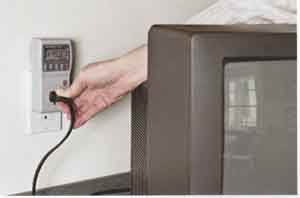
An inexpensive energy monitor like this one ($30)
can tell you how much any plug-in electrical device costs you, per hour
or over a period of time.
Go Green—Cut Your Carbon Footprint (SuperTip 13) Because electricity has two to three times the carbon emissions per unit of energy as fossil fuels, saving electric usage has a bigger effect on your greenhouse gas emissions than saving an equivalent amount of gas, oil, or propane. and because electricity costs more per unit of energy than fossil fuels, it also means more money back in your pocket. |
Energy myth (SuperTip 14) “Power Surges From Turning On An Electric Device Use More Energy Than Leaving The Device On” This is a myth born of Laziness. The initial power surge from turning on any light, computer, or appliance consumes the same energy as just a few seconds of actual operation. So when you’re not using it, turn it off. |
TEST EACH APPLIANCE (SuperTip 15)
One type of monitor works with plug-in lights and appliances—plug it into the wall, and plug the appliance into it. Following the directions, you can enter your electricity cost and find out how much each appliance costs to use. You can check each device individually to see how much it uses when it’s on, and find out if it’s really off when you turn it off
You can also set it to monitor an item over time to find out how much that entertainment center or refrigerator uses in a week. This is especially useful for things like refrigerators or dehumidifiers that cycle on and off over time. This type of meter is less expensive than a whole-house meter and more convenient for checking one item at a time.
TEST YOUR WHOLE HOUSE (SuperTip 16)
Another type of energy monitor checks your whole house at once. One product works by clamping onto your electric meter; another uses sensors installed in your main electrical panel (please follow directions carefully and get help from an electrician if you need it).
The whole-house monitor checks all your electric users, including the lights and appliances that are wired directly to your house. It can tell you how many dollars per hour you use at any given time, as well as over time. Because they monitor the whole house at once, some of these meters have software to help you understand the use as individual items turn on and off (like your furnace fan). With others, it’s up to you to turn items on and off to get a sense of how much electricity they use.
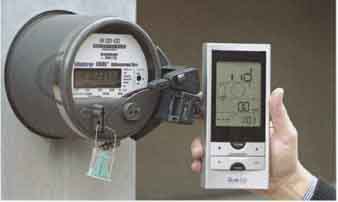
A whole-house energy monitor is more expensive ($150
to $250), but it gives you feedback about the electrical use of your
entire home, including permanently wired lights and appliances like
furnace fans and pool pumps.
Seeing in the Dark
We need lights to read, work, and find our way to the bathroom in the middle of the night. We don’t need to waste energy, and carbon emissions, with our lights. Lighting is sixth on the list of largest electricity consumers in the home (see the chart on below), amounting to about $100 per year for the average household. It’s also one of the easiest to cut—efficient lighting can shave 60 percent off that part of your bill.
INSTALL COMPACT FLUORESCENT LIGHTS (SuperTip 17)
When I first started installing efficient compact fluorescent lights (CFLs) 18 years ago, they were disappointing. They took time to warm up, and they had a greenish tinge and awkward shapes that made them hard to install and harder to like. and they cost nearly $20 per bulb.
Now CFLs are smaller, are brighter, look better, and start instantly, and the price has come down to just a few dollars per bulb. Because they last eight to ten times longer than a regular bulb, they actually save you on replacement costs over several years—I still have CFLs in my kitchen that have been in use several hours a day for more than 14 years.
Install CFLs in any fixture that sees more than two hours of use at a time, such as lights in the kitchen, living/family room, and kids’ rooms; outdoor lights; or any light on a daily timer. This gives you the most savings up front.
If you want to put CFLs in a light with a dimmer or electronic control, be sure to get one that is rated for a dimmer, otherwise it won’t work properly and could be a fire hazard. This is also true for some electronic timer controls. Another thing to be careful about is that in very cold weather (well below freezing), some CFLs used in outdoor lights can start slowly or be dim for several minutes.
Go Green—install solar electricity (SuperTip 17) Solar electric panels, called photovoltaic (PV) modules, can be mounted on a roof or a stand to generate electricity to power your house and even run your meter backward when you generate more power than you use. PV panels reduce fossil fuel use and carbon emissions, but they are expensive. Even with state and federal tax credits and other grants, it’s almost always more cost-effective to spend your money on energy efficiency first. Then, to be even greener, use your savings to pay for some solar panels. |
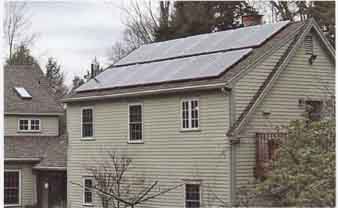
Solar-generated electricity using photovoltaic technology
is a great way to reduce your electric bill and help the environment;
however, it’s almost always better to invest in efficiency first.
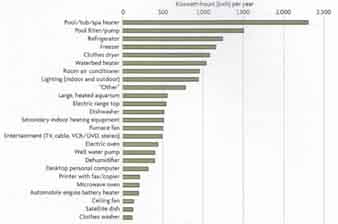
Top 25 Electricity Users in American Homes:
Note that these amounts represent averages for all users in each category.
If you have any of these devices, your actual usage may be much higher
or much lower than what’s shown here. It also doesn’t include usage for
electric heating, central air-conditioning, or water heating. Pool/tub/spa
heater Pool filter/pump; Refrigerator; Freezer; Clothes dryer; Waterbed
heater; Room air conditioner; Lighting (indoor and outdoor); “Other”;
Large, heated aquarium Electric range top; Dishwasher; Secondary indoor
heating equipment; Furnace fan; Entertainment (TV, cable, VCR/DVD, stereo);
Electric oven; Well water pump; Dehumidifier; Desktop personal computer;
Printer with fax/copier; Microwave oven; Automobile engine battery heater;
Ceiling fan; Satellite dish; Clothes washer.
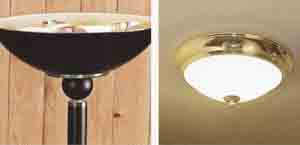
(left) CFL floor lamps like this are much
safer than units with halogen bulbs and use up to 80 percent less electricity
than standard models. (right) Using fixtures with built-in CFLs can save
on replacement costs and energy, especially when you’re planning to buy
a light fixture anyway. Look for the ENERGY STAR label on the box.
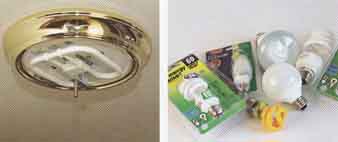
This CFL fixture has a special bulb that
spreads the light around evenly behind the glass, getting more of it out
where it’s needed. (right) A Compact fluorescent Light bulbs use 60 percent
to 70 percent less electricity, burn cooler, and last longer than regular
light bulbs. An ENERGY STAR label ensures efficiency and quality standards.
REPLACE OLD LIGHT FIXTURES (SuperTip 19)
Although many light fixtures accommodate the new, smaller CFLs, some types don’t. In this case, or whenever you are buying a new light fixture, consider buying a pin-based CFL fixture.
Many lighting manufacturers have a range of good-quality light fixtures that utilize a plug—in (rather than screw—in) CFL bulb. There are two advantages: First, you don’t have to buy the electronic base (called ballast) every time you replace the bulb, as you do with screw-in CFLs where the ballast is part of the bulb. Second, the fixtures are designed for CFLs, so many are more efficient at getting the light out of the fixture more effectively—giving you more light where you need it for each dollar of energy. This is especially true for CFL recessed “can” lights and exterior floodlights, where installing a screw-base CFL may reduce the available light.
Go Green--PLEASE TURN OFF THE LIGHTS (SuperTip 20): It’s free, and it saves energy. From an early age, was conditioned to turn the tights off whenever leave a room. Doing that can save a tot of energy over time. Of course, when they are on, efficient tights are stilt better than regular light bulbs.
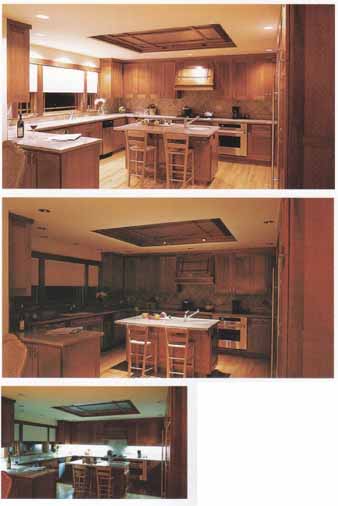
Good lighting in work areas allows you to use
less overall lighting in your kitchen and other rooms. Under- cabinet
lights make good task lights for countertops and recessed halogen lights
double as task lights for an island or table, offering accent lighting
when used alone. Cove lights or recessed lights make good ambient lights.
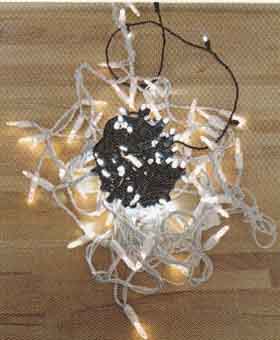
A For indoor or outdoor holiday light strings,
LEDs can’t be beat for both longevity and efficiency.
IMPROVE YOUR LIGHTING (SuperTip 21)
Most of us want general area lighting mixed with focused task lighting. This is especially important in kitchens, where under-cabinet lights or pendant lights are more pleasing and more efficient than lighting the whole room with recessed can or ceiling fixtures. If you are planning a kitchen remodel, plan for maximum lighting efficiency.
Short strings of white holiday lights--used year-round--are a great way to add sparkle and background lighting without deep shadows, at only 20w to 40w. String them around windows, across beams, or around the edge of a ceiling (I have several strings in my house, on light switches so they are easy to turn on and off). LED (light-emitting diode) holiday lights use even less power.
LEDs, which are common in electronics, have been widely adopted for uses like traffic lights and exit signs, but they are not yet widely available as substitutes for regular light bulbs. Although they do have some promise (they are super-efficient, are less bulky, and have a much longer life even than CFLs), they are still expensive, and those that are available have limited light output. Currently, the best LED products for homeowners are specialty applications: small spotlights for accent lighting, under—cabinet strip lights, candelabra/chandelier fixtures, and holiday light strings.
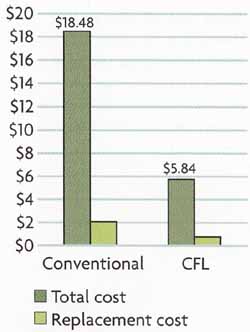
Total Annual Use Cost and Replacement Cost of
Regular Bulbs Compared to CFLs
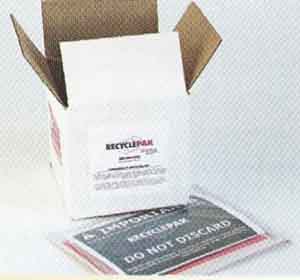
(SuperTip 22) Energy myth: Because compact
fluorescent lights contain mercury, there’s no net environmental benefit.
The tiny amount of mercury in CFLs is still a net gain for the
environment. Coal-burning power plants are the largest man-made source
of mercury in the environment, so the electricity saved over the life
of one CFL actually reduces mercury emissions, as well as saving greenhouse
gases and your money. This pre-paid box can handle up to 12 CFLs for recycling,
at less than $1.50 per bulb, from Energy Federation Incorporated (EEI).
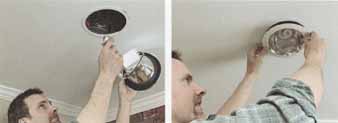
(left) A Installing a new airtight, CFL-based
insert is almost as easy as screwing in a new light bulb. This dimmable
unit from TCP costs about $40 (www.di.org) and will help you save on
your lighting bill, as well as your heating and cooling. (right) The
recessed-light insert has a built-in reflector that sits inside the
existing recessed can. If the existing can is not tight to the drywall,
you may need to caulk the gap before setting the insert in place.
INSTALL INSERTS FOR. RECESSED LIGHTS (SuperTip 23)
Recessed can lights have two problems: They have poor lighting efficiency and they leak air like crazy. First, identify priority fixtures that open into an attic or are mounted in cathedral ceilings. These may be replaced entirely with new, airtight cans that are rated for insulation contact. You may want the help of an electrician for that. You can then install CFL reflector bulbs that direct the light downward efficiently.
A simpler, less expensive solution is to fill each of these can lights with an insert that provides an air seal and a plug-in CFL bulb. The insert stops the airflow, and saves electric use. The CFL base means you don’t have to buy replacement ballast with each bulb. Finally, for can lights in ceilings that have finished rooms above, simply replace the bulbs with screw-in CFL reflector bulbs.
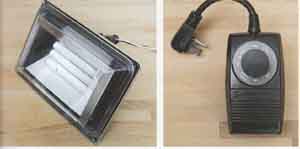
(left) This compact fluorescent outdoor floodlight
is a good choice if you want the light on for longer periods. (right)
A plug-in timer can ensure that you have light when you need it, and (unlike
people) it won’t forget to turn the lights off at bedtime.
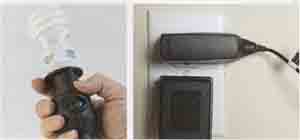
(left) A screw-in daylight sensor will ensure
that the light only comes on at night. (right) “Wall cube” power adapters
use energy any time they are plugged in, even if nothing is attached.
They are, however, getting smaller and more efficient over time. These
cubes both charge the same cell phones, but the newer one (above) with
the ENERGY STAR label uses a fraction of the power.
CONTROL YOUR LIGHTS (SuperTip 24)
For outdoor security lights, or indoor lights used regularly, use a timer. For wired light fixtures, you’ll need to install the timer in place of the on-off switch, so get the help of an electrician if you’re not experienced with wiring projects.
For indoor plug-in lamps, buy a timer that plugs into the wall outlet. For exterior lights, here’s an even better option: Install a motion—plus—daylight sensor. You don’t even need to use CFL bulbs, because the lights will only be on for short periods (although a halogen floodlight will improve the efficiency of outdoor fixtures by about 30 percent). You can replace the whole fixture or add the sensors to an existing floodlight.
INSTALL A LIGHT TUBE (SuperTip 25)
Also called a “tubular skylight,” this is a great way to bring natural outdoor light into a dark area. A light tube also reduces the need for electric lights in dark areas. With a price tag of $200 to $500, it may take many years for the tube to pay for itself in saved electricity, but there are aesthetic and health benefits to natural light as well. It’s cheaper than a skylight, is easier to install, and contributes less to winter heat loss and summer heat gain. Installation requires access to a roof or attic space directly above.
A light tube looks like a domed ceiling-light fixture, but instead of being powered by electricity, it’s lit by natural sunlight from a collector dome on the roof.
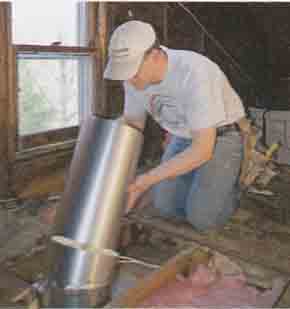
A tubular skylight provides natural outdoor light
to dark spaces, without the carpentry or logistical hassles of installing
a conventional skylight.
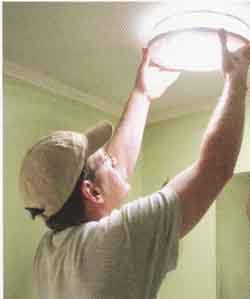
A From inside the house, a light tube looks like
a domed fixture, but it brings in bright natural light from outdoors and uses no electricity.
Plug Your Electricity Leaks
Besides lights, your home has lots of other plug-in electrical items. But when you turn off the switch, are they really off?
Many electronic gadgets use electricity whenever they’re plugged in. Sometimes called “phantom loads” or “leaking electricity,” these devices come in two types: those that maintain a “standby” state so you can turn them on with remote controls, to power clocks, or simply to wait for user input, like a printer; and those powered by plug-in “wall cubes” and AC/DC power supply adaptors. Both types typically use less power in standby mode than when fully on, but even so, it’s equivalent to leaving a car idling 24/7 in your driveway, just so you don’t have to bother cranking it on when it’s time to go.
The VCR/DVD, cable box, network router—all can consume between 5w and 30w around the clock and may cost you Sl00 to $500 each year, amounting to roughly 5 percent of the average electricity bill. Cutting back on electrical use that has little or no tangible benefit saves you money and helps the environment.
Tip: Most families have several cell-phone chargers at home; unplug them when the phones aren’t charging, or put them on a power strip.
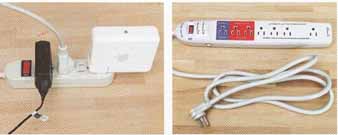
(left) Plug items that don’t need to be on 24/7
into a power strip, and turn it off when you are finished. (right) This Smart
Strip shuts off nonessential items (printer, scanner, monitor, VCRs,
etc.) in a home office or entertainment center when you turn off the
“main” item.
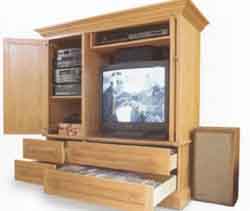
A Keep an eye on that entertainment center: Use
a power strip or wall switch to turn off all the devices that don’t
have to stay on 24/7.
Go green (SuperTip 26)
When it comes to standby power, not all electronics are the same in a test comparing high-definition TVs, more than half of the 33 models in the 50-in, to 65-in range used less than 1w in standby, with the lowest a 58-in, model that used 0.3w. Five in the 50-in, to 65-in, range used more than 20w continuously. The least efficient model was a 65-in, unit that consumed more than 76w when it’s off — that’s nearly $100 a year for just one TV. it used 250 times as much as the most efficient model and more than 27 times as much as the most efficient 65-in, unit. Standby power is not typically listed in the specs for consumer electronics, so you have to be a smart shopper. For HDTV test results and search Google for “HDTV television power consumption.”
SWITCH IT OFF (SuperTip 27)
Use a power strip for items that don’t have to be on when you’re not there, so you can really turn them off when you’re not using them. Of course, some devices, like a digital video recorder or anything with a clock, need to be powered all the time.
Get a power strip with a lighted switch to help you remember when it’s on. If you still have trouble remembering, a power strip that can help is the Smart Strip (see the center photo above). Also, if your house is wired with light-switch-controlled outlets, plug the nonessential items into those outlets. You can even replace the switch with a motion sensor; then the items turn on automatically when you enter the room.
(SuperTip 28) TURN OFF THE SCREEN SAVER
If you use a desktop computer, this one choice can save you up to $100 a year. Screen savers were developed to prevent screens from burning out certain pixel areas during periods of inactivity. With today’s technology, it’s far better to “blank” the screen by turning the monitor off after a few minutes or put the whole computer in standby mode.
Many screen savers use complex graphics and actually increase computer power consumption. Some screen savers even prevent the power management software from operating, so it’s best to completely deactivate all screen savers.
(SuperTip 29) GIVE YOUR COMPUTER A REST
Lull your computer to sleep—use “standby” or “hibernate” mode. If you have Microsoft Windows, go to “Control Panel—Power Options.” Choose the power scheme “max energy savings” (or “max battery” for laptops). Or, you can set custom time delays for inactivity until the system shuts off the monitor or hard drive, or goes into standby.
On a Mac, choose “System Preferences—Energy Saver”; it’s called “sleep” instead of standby. You can independently set times for the monitor or the computer to go to sleep. On either system, when the monitor is off, the computer keeps working in the background. In standby or sleep, activity stops, but it takes just a few seconds to turn back on, right where you left off. Any machine can easily be configured to wake up automatically for scheduled events, or when a fax or modem rings.
In Windows, the “Power Options” setting allows independent settings for screen, hard drive, standby, and hibernate modes. Additional tabs allow customizing power mode buttons (“Advanced”) and enabling of a no-power “Hibernate” mode.
(SuperTip 30) BE AN ENERGY STAR SHOPPER
One of the best ways to help reduce energy use is to buy products with an ENERGY STAR label whenever you can. ENERGY STAR has labels for efficient home electronics in the following categories: battery chargers for cordless tools, appliances, and personal care products; power adapters; cordless phones; digital-to-analog converter boxes; home audio components; DYD products; and TVs Andover.
With the popularity of home offices, it’s worth knowing about ENERGY STAR—rated office equipment as well. These product groups include computers, notebook computers, tablet PCs, and computer monitors; printers, scanners, and all-in—ones; copier and fax machines; digital duplicators: mailing machines; and water coolers.
(SuperTip 31) Energy myth: Turning your computer off wears it out, so it’s better to leave it on: This is a holdover from 1980s technology, when hard drives were prone to failure. Modern computers don’t suffer from power cycling. In fact, turning them off or put ting them in standby helps them last longer by reducing heat and mechanical wear. With modern energy-saving technologies, and much more stable operating systems, using a standby, sleep, or hibernate mode will get you back up and running reliably, much faster than rebooting.
Tip: On a desktop computer, don’t shut off the machine with a power strip if it’s in standby, because you can lose your work. Hibernate (available with Windows) is an advanced standby mode that saves the computer’s entire operating state to the hard drive. This allows you to cut power completely to your computer; when a laptop hibernates, it literally shuts off the battery. When you turn a computer back on from hibernate, it comes up right where you left off. Hibernate is the best type of standby mode for tong periods, especially overnight, because you can safely turn the power off completely.
Next: Large Appliances